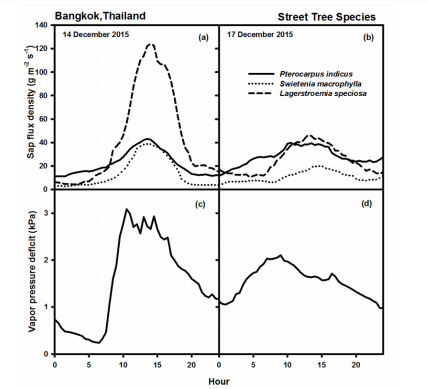Responses of Sap Flux Density to Changing Atmospheric Humidity in Three Common Street Tree Species in Bangkok, Thailand
Main Article Content
Abstract
Efficient water management in urban landscape is imperative under the projected increases in drought stress under future climate. Because different tree species have different stomatal regulations to prevent water loss under water limitation, comparative study of species-specific responses of water use to changing weather conditions will benefit selective planting of urban trees for sustainable urban greening management. In this study, a simple and short-term investigation of water use characteristics of three common street tree species in Bangkok, a major city in Southeast Asia was performed. Species included Pterocarpus indicus (Pi), Swietenia macrophylla (Sm) and Lagerstroemia speciosa (Ls). Self-constructed heat dissipation probes were used to track water uptake rates, expressed as sap flux density (JS), in stems of potted trees and to examine their diurnal variations with changing atmospheric humidity, represented by vapor pressure deficit (D). The results implied that two of the three species: Pi and Sm, may be selected for planting because their Js was less sensitive to changing D, compared to Ls. The sap flux density of Ls increased more rapidly with rising D, implying higher sensitivity to drought in Ls, compared to the other two species. Nevertheless, further study on large trees and under a longer period of investigation, covering both dry and wet seasons, is required to confirm this finding.
Article Details
How to Cite
Tor-ngern, P., & Panha, S. (2016). Responses of Sap Flux Density to Changing Atmospheric Humidity in Three Common Street Tree Species in Bangkok, Thailand. Environment and Natural Resources Journal, 14(2), 24–29. retrieved from https://ph02.tci-thaijo.org/index.php/ennrj/article/view/69513
Section
Original Research Articles
Published articles are under the copyright of the Environment and Natural Resources Journal effective when the article is accepted for publication thus granting Environment and Natural Resources Journal all rights for the work so that both parties may be protected from the consequences of unauthorized use. Partially or totally publication of an article elsewhere is possible only after the consent from the editors.

